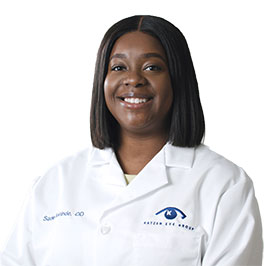Glaucoma
What is Glaucoma?
Glaucoma is a group of diseases that damage the optic nerve. The optic nerve contains about 1.2 million nerve fibers. Damage to this nerve can cause blind spots in the field of vision. If the entire nerve is destroyed, blindness occurs.

The front part of the eye contains a clear, nourishing fluid called aqueous, which constantly circulates through the eye. Normally, this fluid leaves the eye through a drainage system and returns to the bloodstream. Glaucoma results from an overproduction of fluid or when the drainage system becomes blocked, causing fluid pressure to increase. Glaucoma is usually caused by increased pressure.
The high pressure causes damage to the optic nerve, resulting in permanent vision loss. The exact reason the fluid system in the eye stops functioning properly is not completely understood. However, research in this area continues to further our understanding of glaucoma.
Because the symptoms of early glaucoma are so slight, the disease often goes unnoticed until permanent vision loss has occurred. Although it can occur at any age, the risk of developing the disease increases dramatically after age 35. It is also more likely to develop in severely nearsighted people with a family history of the condition, are diabetic, or are of African American descent. However, visual damage can be controlled and vision preserved if detected early and properly treated.
The key to preventing serious vision loss or blindness from glaucoma is annual dilated eye examinations. Schedule an annual eye exam with Katzen to have our ophthalmologists assess your vision and recommend the next steps.
Glaucoma Treatment
The effects of glaucoma are permanent, but with early treatment, the loss of vision can be minimized. In some patients, damage occurs so slowly that treatment may not be necessary. However, most patients require some form of treatment, such as eye drops, to prevent or delay vision loss. Following the treatment regimen prescribed by your doctor is extremely important. Without treatment, a gradual loss of vision may occur without you noticing.
Katzen Eye Group uses visual field testing and nerve fiber analyzers to help identify glaucoma and glaucoma suspects much earlier.
Frequently Asked Questions
How long does the initial consultation take?
Allow two hours for the consultation, which includes diagnostic procedures.
How common is glaucoma?
As one of the leading causes of blindness, glaucoma is estimated to affect one in every 50 adults.
Am I at risk of getting glaucoma?
Knowing the risk factors for glaucoma and being screened for it will give you a head start on detecting and treating the disease. Doing so is important because any vision lost in glaucoma patients cannot be regained. Unfortunately, everyone is at risk for developing glaucoma, but certain groups are considered high-risk, including:
- African-Americans (6 to 8 times more likely to develop glaucoma than Caucasians)
- Hispanic Americans in older age groups
- Eye injury patients
- Individuals over the age of 60
- Diabetics or those with high blood pressure
- Those with a family history of glaucoma
- Steroid users
- People with high myopia (severe nearsightedness)
Your best defense is to have regular eye exams and a glaucoma screening test, especially if you fall into a high-risk group.
What are the signs and symptoms of glaucoma?
Glaucoma can progress slowly, and those who present with the disease may already have severe vision loss. Consequently, your best defense is to have regular eye exams and a glaucoma screening test, especially if you fall into a high-risk group.
Open-angle glaucoma is the most common form of the disease. It has no initial symptoms. It isn’t even evident until the optic nerve becomes damaged, and peripheral vision is lost through the slow buildup of pressure in the eyes.
Acute closed-angle glaucoma happens more suddenly when a blockage occurs in the normal flow of eye fluid between the iris and the lens. This type of glaucoma is a medical emergency, and if not treated immediately, could lead to blindness in one to two days. Acute closed-angle glaucoma symptoms include:
- Severe pain
- Nausea
- Vomiting
- Blurred vision
- Seeing a rainbow halo around lights
Another type of glaucoma is called chronic closed-angle glaucoma. This type is similar to open-angle glaucoma, in that it progresses more slowly and can damage the optic nerve without prior symptoms.




